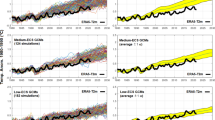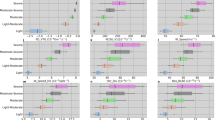Abstract
In a warming climate, atmospheric wave activity and associated weather patterns may change, although conflicting results have been reported on this topic. Additionally, atmospheric wave changes in a future climate have mainly focused on waves of a specified spatial scale, rather than a particular spatiotemporal scale. Here, changes in the variability of Rossby waves of multiple spatiotemporal scales are analyzed using the wavenumber-frequency power spectrum, a tool commonly applied to analyze atmospheric equatorial waves. Daily 500 hPa geopotential height data over 40°–60°N from historical (1950–2005) and future (2006–2099) simulations from 20 models in the Coupled Model Intercomparison Project Phase 5 (CMIP5) under the RCP8.5 scenario were analyzed. When compared to the historical period, the late 21st century climate projections showed a decline in spectral power for both eastward and westward propagating waves with wavenumbers greater than 8 that spanned over all frequencies in all seasons, but an increase in mean power for eastward propagating waves with wavenumbers 1–7 over all frequencies was shown in winter and spring. This increase in power was accompanied by increased variance, i.e., an increased meridional extent of 500 hPa ridges and troughs, and was the result of increases in the mean number of high amplitude events and duration of activity within this wave band. These results indicate that large-scale (~ 104 km) eastward propagating weather systems may intensify with higher amplitudes for ridges and troughs, while short-scale (102–103 km) weather systems may decrease in their intensity due to reduced variability in the late 21st century under the high emissions scenario. Potential mechanisms for these changes are discussed, including enhanced Arctic warming and midlatitude-tropical interactions.







Similar content being viewed by others
References
Arora VK, Scinocca JF, Boer GJ, Christian JR, Denman KL, Flato GM et al (2011) Carbon emission limits required to satisfy future representative concentration pathways of greenhouse gases. Geophys Res Lett 38:L05805. https://doi.org/10.1029/2010gl046270
Baggett C, Lee S, Feldstein S (2016) An investigation of the presence of atmospheric rivers over the North Pacific during planetary-scale wave life cycles and their role in Arctic warming. J Atmos Sci 73:4329–4347. https://doi.org/10.1175/jas-d-16-0033.1
Barnes EA (2013) Revisiting the evidence linking Arctic amplification to extreme weather in midlatitudes. Geophys Res Lett 40:4728–4733. https://doi.org/10.1002/grl.50880
Barnes EA, Polvani LM (2013) Response of the midlatitude jets, and of their variability, to increased greenhouse gases in the CMIP5 models. J Clim 26:7117–7135. https://doi.org/10.1175/jcli-d-12-00536.1
Barnes EA, Polvani LM (2015) CMIP5 projections of Arctic amplification, of the North American/North Atlantic circulation, and of their relationship. J Clim 28:5254–5271. https://doi.org/10.1175/jcli-d-14-00589.1
Bengtsson L, Hodges KI, Roeckner E (2006) Storm tracks and climate change. J Clim 19:3518–3543. https://doi.org/10.1175/jcli3815.1
Bentsen M et al (2013) The Norwegian earth system model, NorESM1-M—Part 1: Description and basic evaluation of the physical climate. Geosci Model Dev 6:687–720. https://doi.org/10.5194/gmd-6-687-2013
Blackmon ML (1976) A climatological spectral study of the 500 mb geopotential height of the Northern Hemisphere. J Atmos Sci 33:1607–1623. https://doi.org/10.1175/1520-0469(1976)033%3c1607:acssot%3e2.0.co;2
Byrne MP, Schneider T (2016a) Energetic constraints on the width of the intertropical convergence zone. J Clim 29:4709–4721. https://doi.org/10.1175/jcli-d-15-0767.1
Byrne MP, Schneider T (2016b) Narrowing of the ITCZ in a warming climate: Physical mechanisms. Geophys Res Lett 43:11,350–11,357. https://doi.org/10.1002/2016gl070396
Chang EKM, Fu Y (2002) Interdecadal variations in northern hemisphere winter storm track intensity. J Clim 15:642–658. https://doi.org/10.1175/1520-0442(2002)015%3c0642:ivinhw%3e2.0.co;2
Chang EKM, Lee S, Swanson KL (2002) Storm track dynamics. J Clim 15:2163–2183. https://doi.org/10.1175/1520-0442(2002)015%3c02163:std%3e2.0.co;2
Cohen J, Zhang X, Francis J, Jung T, Kwok R, Overland J et al (2018). Arctic change and possible influence on mid-latitude climate and weather: a US CLIVAR white paper (No. 2018-1). In: Uhlenbrock K (ed) Washington, DC: U.S. CLIVAR Project Office. https://doi.org/10.5065/d6th8kgw
Collier M, Uhe P (2012) CMIP5 datasets from the ACCESS1.0 and ACCESS1.3 coupled climate models. Centre for Australian Weather and Climate Research Tech. Rep. http://www.cawcr.gov.au/technical-reports/CTR_059.pdf. Accessed 24 May 2019
Dai A, Luo D, Song M, Liu J (2019) Arctic amplification is caused by sea-ice loss under increasing CO2. Nat Commun 10:1–13. https://doi.org/10.1038/s41467-018-07954-9
Dee DP et al (2011) The ERA-Interim reanalysis: configuration and performance of the data assimilation system. Q J R Meteorol Soc 137:553–597. https://doi.org/10.1002/qj.828
Dole R et al (2011) Was there a basis for anticipating the 2010 Russian heat wave? Geophys Res Lett 38:L06702. https://doi.org/10.1029/2010gl046582
Donner LJ et al (2011) The dynamical core, physical parameterizations, and basic simulation characteristics of the atmospheric component AM3 of the GFDL global coupled model CM3. J Clim 24:3484–3519. https://doi.org/10.1175/2011jcli3955.1
Dufresne JL, Foujols MA, Denvil S, Caubel A, Marti O, Aumont O, Balkanski Y, Bekki S (2013) Climate change projections using the IPSL-CM5 earth system model: from CMIP3 to CMIP5. Clim Dyn 40:2123–2165. https://doi.org/10.1007/s00382-012-1636-1
Feser F, Barcikowska M, Krueger O, Schenk F, Weisse R, Xia L (2015) Storminess over the North Atlantic and northwestern Europe—a review. Q J R Meteorol Soc 141:350–382. https://doi.org/10.1002/qj.2364
Fogli FG, Manzini E, Vichi M, Alessandri A, Patara L, Gualdi S, Scoccimarro E, Masina S, Navarra A (2009) INGV‐CMCC carbon (ICC): a carbon cycle Earth system model, CMCC Res. Pap. 61, Euro‐Mediterr. Cent. for Clim. Change, Lecce, Italy. http://ssrn.com/abstract=1517282. Accessed 24 May 2019
Francis JA (2017) Why are Arctic linkages to extreme weather still up in the air? Bull Am Meteorol Soc 98:2551–2557. https://doi.org/10.1175/bams-d-17-0006.1
Francis JA, Vavrus SJ (2012) Evidence linking Arctic amplification to extreme weather in midlatitudes. Geophys Res Lett 39:L06801. https://doi.org/10.1029/2012gl051000
Fu R (2015) Global warming-accelerated drying in the tropics. Proc Natl Acad Sci USA 112:3593–3594. https://doi.org/10.1073/pnas.1503231112
Giorgetta MA et al (2013) Climate and carbon cycle changes from 1850 to 2100 in MPI-ESM simulations for the Coupled Model Intercomparison Project phase 5. J Adv Model Earth Sy 5:572–597. https://doi.org/10.1002/jame.20038
Griffies SM et al (2011) The GFDL CM3 coupled climate model: characteristics of the ocean and sea-ice simulations. J Clim 24:3520–3544. https://doi.org/10.1175/2011jcli3964.1
Hassanzadeh P, Kuang Z (2015) Blocking variability: arctic amplification versus Arctic oscillation. Geophys Res Lett 42:8586–8595. https://doi.org/10.1002/2015gl065923
Hassanzadeh P, Kuang Z, Farrell BF (2014) Responses of midlatitude blocks and wave amplitude to changes in the meridional temperature gradient in an idealized dry GCM. Geophys Res Lett 41:5223–5232. https://doi.org/10.1002/2014gl060764
Jones CD et al (2011) The HadGEM2-ES implementation of CMIP5 centennial simulations. Geosci Model Dev 4:543–570. https://doi.org/10.5194/gmd-4-543-2011
Kanamitsu M, Ebisuzaki W, Woollen J, Yang S-K, Hnilo JJ, Fiorino M, Potter GL (2002) NCEP–DOE AMIP-II reanalysis (R-2). Bull Am Meteorol Soc 83:1631–1643. https://doi.org/10.1175/bams-83-11-1631
Kidston JS, Dean SM, Renwick JA, Vallis GK (2010) A robust increase in eddy length scale in the simulation of future climates. Geophys Res Lett 37:L03806. https://doi.org/10.1029/2009gl041615
Kidston JS, Vallis GK, Dean SM, Renwick JA (2011) Can the increase in the eddy length scale under global warming cause the poleward shift of the jet streams? J Clim 24:3764–3780. https://doi.org/10.1175/2010jcli3738.1
Luo D, Cha J, Zhong L, Dai A (2014) A nonlinear multi-scale interaction model for atmospheric blocking: the eddy-blocking matching mechanism. Q J R Meteorol Soc 140:1785–1808. https://doi.org/10.1002/qj.2337
Luo D, Yao Y, Dai A, Simmonds I, Zhong L (2017) Increased quasi-stationarity and persistence of winter Ural blocking and Eurasian extreme cold events in response to Arctic warming. Part II: A theoretical explanation. J Clim 10:3569–3587. https://doi.org/10.1175/jcli-d-16-0262.1
Luo D, Chen X, Dai A, Simmonds I (2018) Changes in atmospheric blocking circulations linked with winter Arctic warming: a new perspective. J Clim 31:7661–7678. https://doi.org/10.1175/JCLI-D-18-0040.1
Luo D, Zhang W, Zhong L, Dai A (2019) A nonlinear theory of atmospheric blocking: a potential vorticity gradient view. J Atmos Sci 76:2399–2427. https://doi.org/10.1175/JAS-D-18-0324.1
Masunaga H, L’Ecuyer T, Kummerow C (2006) The Madden–Julian oscillation recorded in early observations from the Tropical Rainfall Measuring Mission (TRMM). J Atmos Sci 63:2777–2794. https://doi.org/10.1175/jas3783.1
Peings Y, Cattiaux J, Vavrus SJ, Magnusdottir G (2017) Late twenty-first century changes in the midlatitude atmospheric circulation in the CESM large ensemble. J Clim 30:5943–5960. https://doi.org/10.1175/jcli-d-16-0340.1
Raghavendra A, Guinn TA (2016) Breakdown of ITCZ-like PV patterns. Beyond Undergrad Res J 1:1–11. https://commons.erau.edu/beyond/vol1/iss1/1/]
Raghavendra A, Roundy PE, Zhou L (2019a) Trends in tropical wave activity from 1980s–2016. J Clim 32:1661–1676. https://doi.org/10.1175/jcli-d-18-0225.1
Raghavendra A, Dai A, Milrad SM, Cloutier-Bisbee SR (2019b) Floridian heatwaves and extreme precipitation: future climate projections. Clim Dyn 52:495–508. https://doi.org/10.1007/s00382-018-4148-9
Rencurrel MC, Rose BEJ (2018) Exploring the climatic response to wide variations in ocean heat transport on an aquaplanet. J Clim 31:6299–6318. https://doi.org/10.1175/jcli-d-17-0856.1
Roundy PE (2018) A wave-number frequency wavelet analysis of convectively coupled equatorial waves and the MJO over the Indian Ocean. Q J R Meteorol Soc 144:333–343. https://doi.org/10.1002/qj.3207
Roundy PE (2019) Interpretation of the spectrum of eastward-moving tropical convective anomalies. Q J R Meteorol Soc (in press)
Roundy PE, Frank WM (2004) A climatology of waves in the equatorial region. J Atmos Sci 61:2105–2132. https://doi.org/10.1175/1520-0469(2004)061%3c2105:acowit%3e2.0.co;2
Screen JA, Simmonds I (2013) Exploring links between Arctic amplification and midlatitude weather. Geophys Res Lett 40:959–964. https://doi.org/10.1002/grl.50174
Taylor KE, Stouffer RJ, Meehl GA (2012) An overview of CMIP5 and the experiment design. Bull Am Meteorol Soc 93:485–498. https://doi.org/10.1175/bams-d-11-00094.1
Voldoire A et al (2013) The CNRM-CM5.1 global climate model: description and basis evaluation. Clim Dyn 40:2091–2121. https://doi.org/10.1007/s00382-011-1259-y
Watanabe M et al (2010) Improved climate simulation by MIROC5: mean states, variability, and climate sensitivity. J Clim 23:6312–6335. https://doi.org/10.1175/2010jcli3679.1
Watanabe S et al (2011) MIROC-ESM 2010: model description and basic results of CMIP5-20c3m experiments. Geosci Model Dev 4:845–872. https://doi.org/10.5194/gmd-4-845-2011
Wheeler M, Kiladis GN (1999) Convectively coupled equatorial waves: analysis of clouds and temperature in the wavenumber-frequency domain. J Atmos Sci 56:374–399. https://doi.org/10.1175/1520-0469(1999)056%3c0374:ccewao%3e2.0.co;2
Yin JH (2005) A consistent poleward shift of the storm tracks in simulations of 21st century climate. Geophys Res Lett 32:L18701. https://doi.org/10.1029/2005gl023684
Yukimoto S et al (2011) Meteorological Research Institute earth system model version 1 (MRI-ESM1)—Model description. Technical Reports of the Meteorological Research Institute. http://www.mri-jma.go.jp/Publish/Technical/DATA/VOL_64/index_en.html. Accessed 24 May 2019
Yukimoto S et al (2012) A new global climate model of the Meteorological Research Institute: MRI-CGCM3—model description and basic performance. J Meteorol Soc Japan 90a:23–64. https://doi.org/10.2151/jmsj.2012-a02
Zappa G, Shaffrey LC, Hodges KI, Sansom PG, Stephenson DB (2013) A multi-model assessment of future projections of north Atlantic and European extratropical cyclones in the CMIP5 climate models. J Clim 26:5846–5862. https://doi.org/10.1175/jcli-d-12-00573.1
Zhou L (2016) Desert amplification in a warming climate. Sci Rep 6:31065. https://doi.org/10.1038/srep31065
Acknowledgements
We thank the CMIP5 modeling groups, the Program for Climate Model Diagnosis and Intercomparison and the WCRP’s Working Group on Coupled Modelling for their efforts in making the CMIP5 multimodel dataset listed in Table 1 available through the Earth System Grid Federation (https://esgf-node.llnl.gov/projects/esgf-llnl/). Aiguo Dai and Heather S. Sussman acknowledge funding support from the Science, Mathematics, and Research for Transformation (SMART) Fellowship, the National Science Foundation (AGS-1353740 and OISE-1743738), the U.S. Department of Energy’s Office of Science (DE-SC0012602), and the U.S. National Oceanic and Atmospheric Administration (NA15OAR4310086 and NA18OAR4310425). Ajay Raghavendra acknowledges funding support from NSF AGS-1535426, and Paul E. Roundy acknowledges funding support from NSF AGS-1358214 and AGS-1128779. The authors also thank Dr. Elizabeth A. Barnes for insightful discussions that helped to improve the quality of this work. The authors also extend gratitude to the two anonymous reviewers for their detailed and constructive comments that have tremendously improved the quality of this work and Dr. Susanna Corti for serving as the Editor of this paper.
Author information
Authors and Affiliations
Corresponding author
Additional information
Publisher's Note
Springer Nature remains neutral with regard to jurisdictional claims in published maps and institutional affiliations.
Rights and permissions
About this article
Cite this article
Sussman, H.S., Raghavendra, A., Roundy, P.E. et al. Trends in northern midlatitude atmospheric wave power from 1950 to 2099. Clim Dyn 54, 2903–2918 (2020). https://doi.org/10.1007/s00382-020-05143-3
Received:
Accepted:
Published:
Issue Date:
DOI: https://doi.org/10.1007/s00382-020-05143-3




